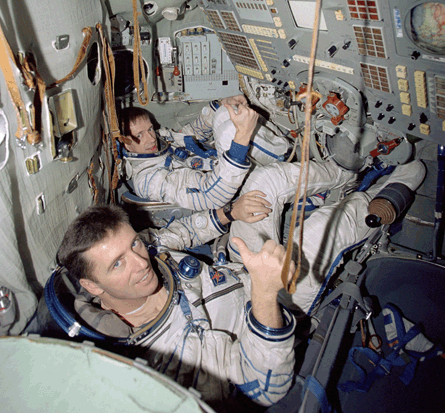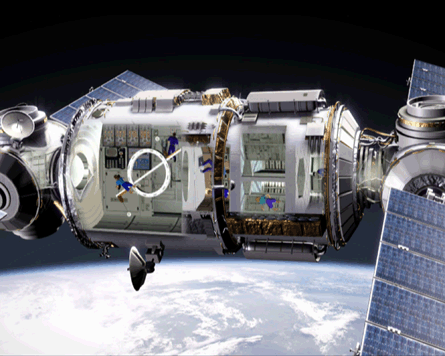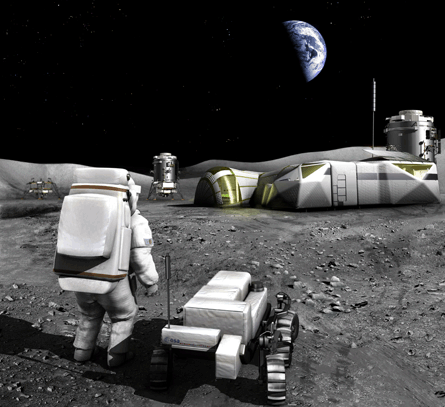Two thousand years of European history have seen many explorers, but the imperial continent was left behind in the space age of the 20th century by the USA and Eurasian Soviet Union as they competed to dominate the high frontier.
Despite a collective population as great as the USA and Russia and a combined gross domestic product comparable to that of the North American superpower, Europe's space activities have for the most part been smaller in scale, focused on science and not supported by an indigenously developed human transport system.
The European Union has followed this approach with its support for International Space Station based research, but the EU may be preparing to expand into human exploration. A "high-level meeting on space exploration" organised by the European Commission will take place this September or October, and the EC says it will be the start of a "process to obtain a common European political vision about the role of Europe in space exploration".
 |
|---|
© ESA |
Originally planned for 25 June in Prague, this delay of a few months will make little difference to the meeting's role in an ongoing process of parallel and complementary activities that have been under way for many years and are increasing EU-European Space Agency bilateral work and international space agency co-operation for Moon and Mars exploration.
Since the beginning of this century EU and ESA bilateral work has been increased through the development of the European space policy. And, over the past four years, a worldwide inter-agency effort to detail a roadmap for exploring Earth's natural satellite and more distant sister planet has resulted in a global exploration strategy. Today this inter-agency effort has culminated in ideas for shipyards circling the Earth and space stations in low lunar orbit.
The European space policy's white paper (an official EC document setting out what the policy should achieve) recommended an investigation into the potential feasibility, costs and opportunity for the EU to participate in the human exploration of the solar system. But by the time the policy was finally agreed in 2007 its focus was more down to earth. It focused on the flagship EU-ESA space-based projects: the satellite navigation system Galileo and Kopernikus, also known as Global Monitoring for Environment and Security (GMES).
However, in 2007 EC enterprise and industry vice-president Günter Verheugen gave the policy a more significant place on the world stage. "Without the European space policy, Europe could become irrelevant. With this resolution on the European space policy, we intend to live up to Europe's global leadership aspirations. Space has always been a source of inspiration," he says.
European space policy explained Jointly drafted by the European Commission and the European Space Agency director general Jean-Jacques Dordain, the European space policy outlines the strategic guidelines for Europe's future activities in space. Through this document, the European Union, ESA and their member states committed themselves to increasing co-ordination of their activities and programmes relating to space. The policy was drawn up with what is described as "the preliminary elements" of a European space programme. These elements include the Galileo satellite navigation system, the Global Monitoring for Environment and Security programme, a commitment to a European launcher capability, and continued use of the International Space Station and investment in other space science endeavours. |
And this more ambitious sentiment has led the EC to organise its high-level event to follow the sixth EU-ESA space council that takes place on 29 May, two years since the space policy was launched.
As the EU's partner in this policy ESA will be able to bring to the table, by October, substantial work on an international exploration vision. The global exploration strategy agencies are working to produce by mid-2011 an international lunar outpost reference mission.
The strategy's agencies formed the International Space Exploration Coordination Group so they could develop the roadmap and its reference missions. Its next meeting is in June in the Netherlands and its last was in March in Yokohama, Japan. Hosted by the Japan Aerospace Exploration Agency (JAXA), there was agreement to study three lunar scenarios until mid-2010. The scenarios are a sortie mission that will see astronauts live on the lunar surface for up to seven days, an extended-stay version of the sortie mission and a lunar outpost. And this work contributes towards the 2011 outpost reference mission.
However, ESA had started studying much earlier a post-ISS future. In January 2008 it began work with NASA on a "comparative assessment study". Its published report included a four-phase ESA roadmap developed by the agency during its earlier work.
 |
|---|
© ESA |
The first phase, extending from 2016 to 2020, would involve ISS utilisation and spacecraft development. Phase two, in the 2020s, envisages low Earth orbit infrastructures that would replace the ISS for the assembly of vehicles, crew exchange and docking operations. ESA thinks Mars sample return missions and low lunar orbit infrastructure are also possibilities. The third phase, in the late 2020s to early 2030s, would involve the lunar outpost. This work would contribute towards the fourth phase, a late 2030s manned Mars mission.
The assessment study with NASA was completed by mid-2008 and in July ESA's industrial partners presented their concepts to the agency as part of an exploration architecture review. "These [industrial] studies were made so we could understand what could be elements of a European contribution [to the international exploration of the Moon and Mars]," says Piero Messina, ESA's human spaceflight directorate's co-ordination office head.
To enable space shipyards and low lunar orbit stations, industry proposed a 50,000kg (110,000lb) to low Earth orbit-capable Ariane-type rocket with six solid rocket boosters, instead of Ariane 5's two, and a twin Vinci engine upper stage. Today the most powerful Ariane 5, the ES ATV, which launches ESA's Automated Transfer Vehicle, can put 20,000kg into LEO.
Three launches of this Ariane X would orbit a lunar lander, its Earth departure stage (EDS) and a second EDS for a crewed spacecraft. The lander and its EDS would dock in Earth orbit and go to a low lunar orbit space station (LSS).
EADS Astrium and Thales Alenia Space each have cargo lunar lander designs and Thales' "medium lander" is a 9,300kg horizontal cylinder concept that is 9.5m (31ft)-long, 4m-wide with a central area for its 1,340kg maximum payload. Operational for 15 days, it uses four 1,800lb-thrust (8kN) Snecma main engines and 16 thrusters of 45lb. All are pressure-fed and all use monomethyl hydrazine and mixed oxides of nitrogen. For night-time heating requirements of up to 100W, regenerative fuel cells and radioactive thermoelectric generators are all being considered.
Thales envisaged lander ground demonstrations until 2014 followed by tethered tests and lunar operations no earlier than 2016.
Astrium's X-Lander development concept evolves a design through to its use on Mars for ExoMars and Mars sample return (MRS). Drop tests from helicopters by 2011 should lead to a lunar first flight in 2016 and the ExoMars rover and MSR missions. Its drop test lander has a 500kg mass and would demonstrate precise landing systems. Astrium expects a robotic lander and a lunar ascent vehicle to need 10,600lb thrust, while a manned descent vehicle would require about 15,700lb.
ESA is not the only agency interested in a concept such as the LSS. JAXA and Roscosmos have also been considering a cislunar orbital complex. But it could be the lunar station or something at the Lagrange L1 point between Earth and Moon.
"Europe will not do this alone. Orbital infrastructure in cislunar space is something Europe could do with its [technological] heritage," says ESA's human spaceflight directorate's head of strategy and architecture office Bernhard Hufenbach. "It could be a staging post."
The cislunar complex could consist of a habitation section and a resource module that would provide power and fuel and possibly be a safe haven for lunar-capable manned spacecraft.
Thales's LSS proposal is a 29,000kg station consisting of a 14,600kg Automated Transfer Vehicle-like service module and 14,400kg ISS node with robotic arm. The LSS could also refuel landers or crewed spacecraft and act as a safe haven in the event of a solar flare incident or crew injury.
Hufenbach cited ESA's International Space Station Columbus laboratory module and the agency's Automated Transfer Vehicle with its fuel and dry cargo capabilities as potential parts of this cislunar station.
 |
|---|
© ESA |
Before the July 2008 ESA exploration industry day the manned spacecraft reaching this LSS with its Ariane X-launched Earth departure stage might have been a joint ESA-Roscosmos vehicle, but last year hopes for that effort faded. Differences over work share between ESA and Roscosmos and the western Europeans' inability to raise enough funding from its member states put an end to this embryonic project.
But a crewed spacecraft could still one day be launched from an ESA spaceport. Beyond the aspirations to man rate an Ariane 5 with its own capsule, in the next 12 months ESA should be launching its first Samara Space Centre Soyuz 2-1a rocket from its new launch pad in Sinnamary in French Guiana.
Sinnamary, which is commercially provided by Arianespace, is a possible launch point for manned flights. According to ESA and CNES space agency officials, no great adjustments to the launch complex would be needed to allow the launch of Samara's Soyuz-FG variant rocket and its Energia rocket and Soyuz TMA crewed spacecraft.
Russia is now developing its advanced crew vehicle (ACV) and ESA has turned its focus on a recoverable cargo spacecraft called the advanced re-entry vehicle (ARV). Roscosmos expects to have preliminary design work completed on the ACV by mid-2010, while ESA is awarding a €14 million ($19.5 million), 18-month ARV phase A contract by July.
Path to Europe's space ambitions
|
That work would inform a 2011 ESA member states ministerial council decision on whether to fully develop the ARV that would come into service in 2017 for the ISS and still be available by 2025. Russia is aiming for ACV to be operational before the end of the next decade.
However, western European aerospace companies could provide subsystems for ACV and ESA's human spaceflight director Simonetta Di Pippo does not rule out a Russian role in ARV. And this western and eastern European collaboration could still be substantial with talks under way on a joint LEO infrastructure.
A tripartite group of EC, ESA and Roscosmos officials, calling itself the spaceships working group, met in March and discussed a LEO shipyard. At the meeting, which ESA director general Jean-Jacques Dordain attended, a shipyard was discussed that would assemble Moon or Mars ships consisting of multinational elements for propulsion, habitation and re-entry capsules.
The shipyard would be a long ISS truss-like structure with robotic remote manipulator systems that would help berth spacecraft elements together. The spacecraft elements would be launched by different countries at different times and automatically reach the shipyard where the robots help berth, integrate and checkout the modular spaceship.
It is a grand ambition but it has the advantage of using all the technologies ESA and its industrial partners have developed to date, including pressurised habitable modules, automatic docking, robotic arms, launchers with 20,000kg capability, re-entry heat shields and upper stages with multiple restart capabilities.
On 27 May Belgian-born astronaut Franke De Winne was launched aboard Russia's Soyuz TMA-15 spacecraft to travel to the ISS. De Winne will become ESA's first ISS commander in October and on the day he was launched Di Pippo said: "This is a source of inspiration for our young students and pupils. Human spaceflight and exploration is gaining momentum and we will be working for Europe to seize bigger opportunities in this field.
"We can further build on the capabilities that made all this possible and look with confidence at the possibility to have a European citizen on the Moon in due time."
Source: Flight Daily News






















